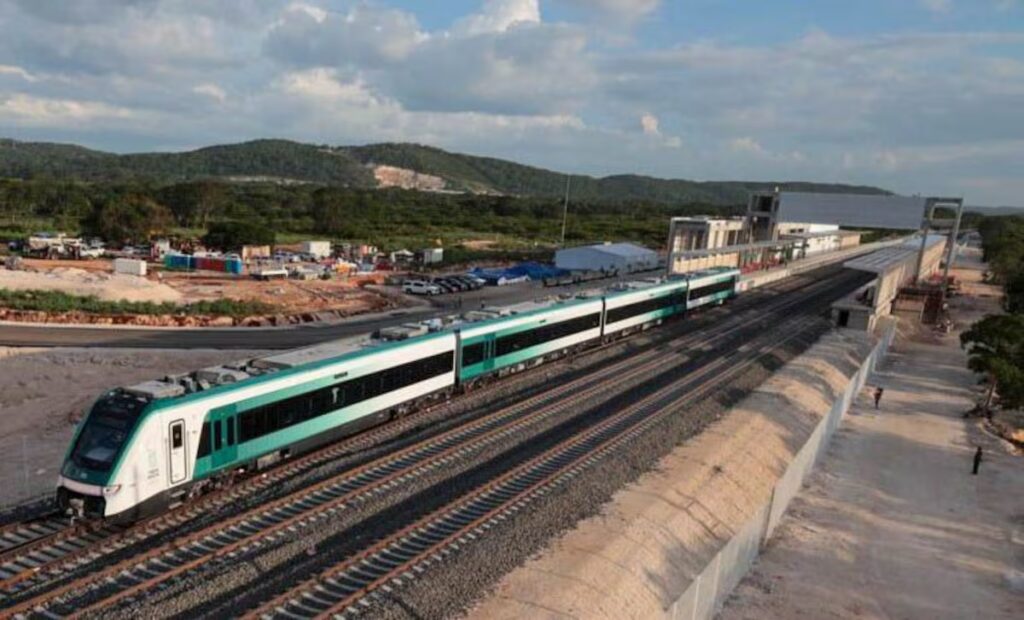
The Mayan Train has been operating in southern Mexico for almost a year. With 1,500 kilometers of track circling the Yucatan Peninsula, this megaproject has been protected by Mexico’s government and criticized by civil society organizations. A group of local, national and international groups released their report on Tuesday Civilian observation mission on impacts and effects in the states of Quintana Roo and Campeche. Focused on sections 5, 6 and 7, the most complex from an ecological point of view and entrusted to the Secretariat of National Defense (Sedena), the document details a total of 15 aspects such as environmental impacts, military, territorial and corporate occupation, insecurity, social impact, land privatization… which, they claim, were caused or accelerated by the Mayan Train.
“We took a trip in April 2025, always with the idea of a civil society initiative to try to monitor and report the progress of the situation of violation of human rights and nature linked to the megaproject,” explains Giovanna Gasparello, anthropologist of the National Institute of Anthropology and History (INAH) and one of the authors. The report follows an investigation by the International Tribunal for the Rights of Nature, a citizen body that documents impacts on ecosystems caused by governments and companies.
The Mayan Train was the megaproject of the Andrés Manuel López Obrador Administration (2018-2024). During its construction, in addition to violations of environmental laws, social conflicts, pollution problems and cost overruns occurred. With a planned budget of 150,000 million pesos, it finally surpassed 500,000 million pesos. While the first sections were built by civilian companies, seeing that they could not finish them within the political deadlines, López Obrador entrusted sections 5, 6 and 7 to the military.
The consequence of this decision is one of the dimensions highlighted in the report: “Military occupation”. “The Mission has heard testimonies of humiliation, abuse of power and overreach by military elements over people, land, community institutions and community public spaces,” reads the document, which indicates that this is combined with a significant deployment of the National Guard (GN), the Secretary of the Navy (Semar) and the Sedena, which has transformed “military intervention into the main disciplinary mechanism for the development of the work”.
“This armed agent is monopolizing the public works sector, the control of the tourism economy and Protected Natural Areas, infrastructures such as ports and airports, arbitrarily occupying public spaces, such as beaches, squares, but also schools and cultural centres”, accuses Gasparello, who points to military idiosyncrasy as the culprit for the fact that there is no one to complain to about the mistreatment of the civilian population.
Among the organizations that participated in this report include, in addition to human rights centers such as the Coordination of the National Indigenous Congress, the Regional Indigenous and Popular Council of Xpujil or the Fray Bartolomé de las Casas Center for Human Rights, environmentalist associations such as Cenotes Urbanos, the Mexican Civil Council for Sustainable Forestry or Greenpeace.
In this field, the document highlights that the construction has generated irreversible environmental impacts, which include land fragmentation, deforestation, the construction of wetlands, the opening of new quarries… Furthermore, analyzes Section 5, the part of the project goes from Cancún to Tulum to Quintana Roo. Its original route, parallel to the highway connecting these cities, was moved several kilometers into the jungle due to pressure from businessmen who did not want the construction to obstruct the entrance to their hotels. This led to “more than 15,000 metal and concrete pillars implanted into the cave system, ignoring the specialists, speleologists and divers who explore and know them, causing damage to 125 cenotes.”
A third aspect that stands out is the axis of real estate speculation, privatization and expropriation. “Following the construction of the railway, land adjacent to and located on the outskirts of the cities crossed by the train increased their price by up to 400%,” the document reads. This also highlights that, during the development of the megaproject, new informal settlements have emerged and “luxury residential settlements are being built that do not have permission for changes in land use, construction or even legal ownership of the land”. This was recognized by the authorities of Quintana Roo, who explained it a year ago Reporturportal specialized in tourism, that the arrival of the Maya Train has increased the irregular sale of large properties along the route.





